Difference between revisions of "Weight"
(Created page with " Using the theoretical differential cross section from previous <center><math>\frac{d\sigma}{d\Omega}=\frac{ \alpha^2 }{4E^2}\frac{ (3+cos^2\theta)^2}{si…") |
|||
| Line 1: | Line 1: | ||
| + | <center><math>\textbf{\underline{Navigation}}</math> | ||
| + | |||
| + | [[VanWasshenova_Thesis#Determining_wire-theta_correspondence|<math>\vartriangleleft </math>]] | ||
| + | [[VanWasshenova_Thesis#Determining_wire-theta_correspondence|<math>\triangle </math>]] | ||
| + | [[CED_Verification_of_DC_Angle_Theta_and_Wire_Correspondance|<math>\vartriangleright </math>]] | ||
| + | |||
| + | </center> | ||
| + | |||
| + | |||
| + | |||
| + | |||
| + | |||
[[Converting_to_barns| Using the theoretical differential cross section from previous]] | [[Converting_to_barns| Using the theoretical differential cross section from previous]] | ||
<center><math>\frac{d\sigma}{d\Omega}=\frac{ \alpha^2 }{4E^2}\frac{ (3+cos^2\theta)^2}{sin^4\theta}</math></center> | <center><math>\frac{d\sigma}{d\Omega}=\frac{ \alpha^2 }{4E^2}\frac{ (3+cos^2\theta)^2}{sin^4\theta}</math></center> | ||
| Line 66: | Line 78: | ||
<center><math>4.97\times 10^{4} barns \times\frac{1.35\times 10^{11}}{barns\cdot s}=6.71\times 10^{15}\frac{electrons}{s}</math></center> | <center><math>4.97\times 10^{4} barns \times\frac{1.35\times 10^{11}}{barns\cdot s}=6.71\times 10^{15}\frac{electrons}{s}</math></center> | ||
| + | |||
| + | |||
| + | <center><math>\textbf{\underline{Navigation}}</math> | ||
| + | |||
| + | [[VanWasshenova_Thesis#Determining_wire-theta_correspondence|<math>\vartriangleleft </math>]] | ||
| + | [[VanWasshenova_Thesis#Determining_wire-theta_correspondence|<math>\triangle </math>]] | ||
| + | [[CED_Verification_of_DC_Angle_Theta_and_Wire_Correspondance|<math>\vartriangleright </math>]] | ||
| + | |||
| + | </center> | ||
Revision as of 14:27, 30 May 2017
Using the theoretical differential cross section from previous
We can take the Moller electron distribution of Theta in the Center of Mass frame, and multiply each given angle Theta by the expected differential cross section.
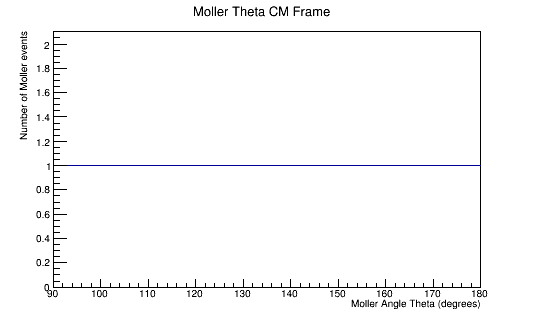
This causes the Moller Theta distribution in the Center of Mass frame to directly follow the theoretical differential cross section.
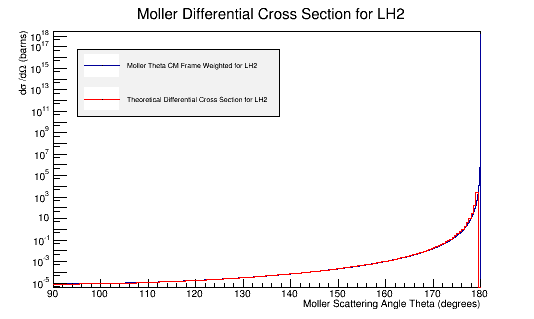
The Lab frame distribution of Theta can also be weighted similarly. However, instead of having it be a differential cross section, we can find the necessary number of particles.
Checking versus the given Luminosity for the experiment
Limiting the range of Theta to within 5 to 40 degrees in the Lab frame:
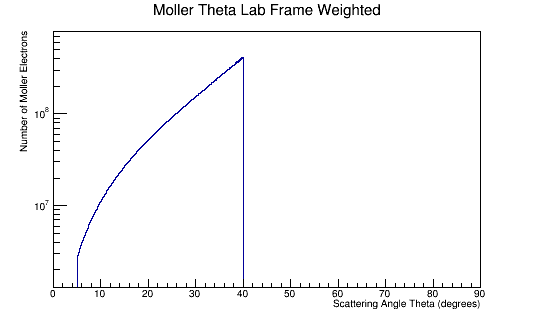
We can find the corresponding angular range in the CM frame:
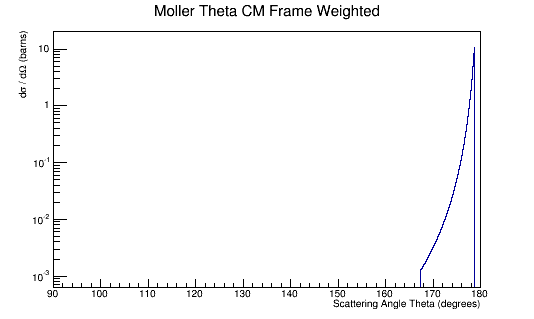
Integrating the differential cross-section over the solid angle:
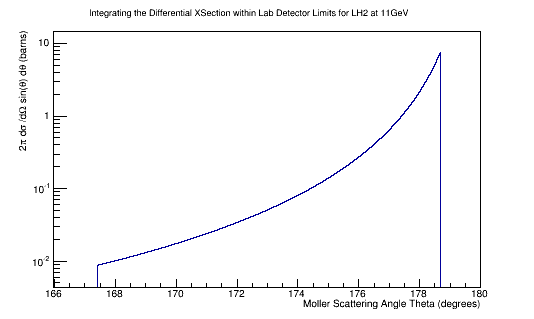
IntegralDiffXSect->Integral()
4.97493824519086629e+04 barns
Multiplying by the Luminosity, we find: